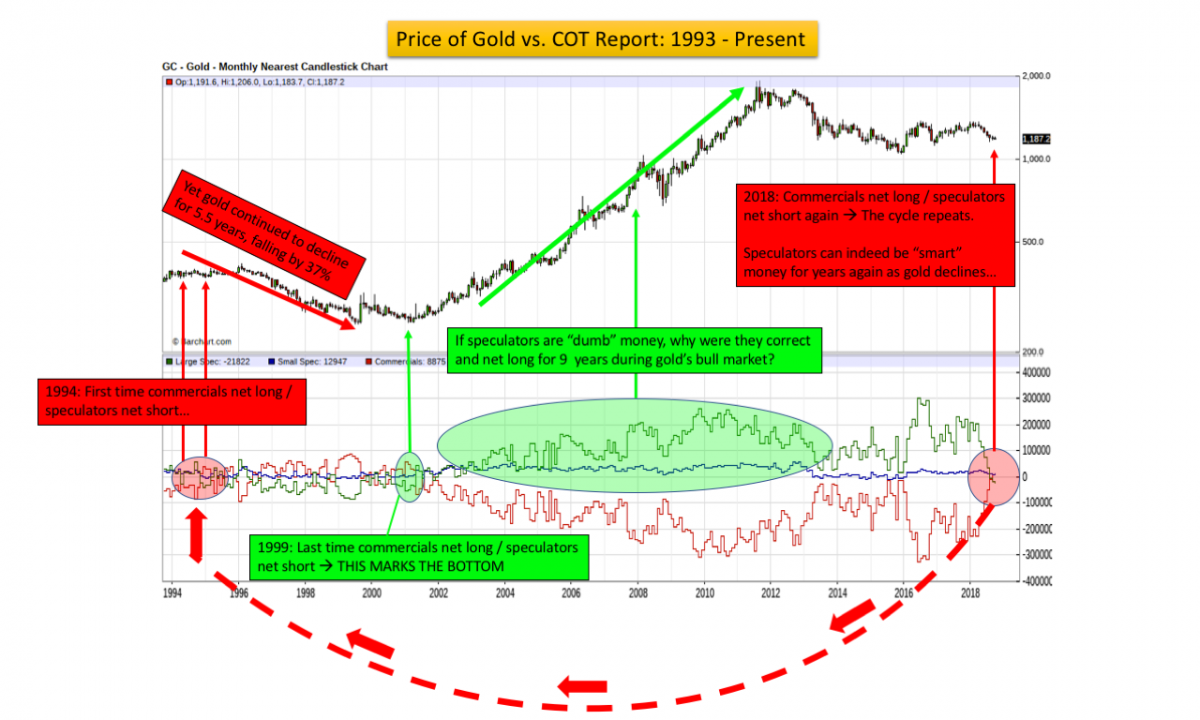Gold COT Myth Debunked – Speculators Are Usually Right

There is a fallacy now spreading throughout the precious metals world, and gold investors who believe it to be true will be making a costly mistake when attempting to navigate the volatility in this market over the next several years.
What is the fallacy we are referring to?
Gold’s Commitment of Traders (COT) Report, and the claim of the bullish setup that is being purported on account of the net long position by commercial traders and net short position by large speculators.
Indeed, not a week goes by that we do not see articles published claiming that this myth is in fact true. We will not name any names here in this article, because the fallacy is nearly universally believed, and a quick Google search for “Gold COT report” will reveal dozens of such misleading articles. The time has come to set the record straight.
What is the COT?
First, what is the COT report?
The Commitment of Traders (COT) is a report published by the governing body of commodities trading in the United States, the Commodity Futures Trading Commission (CFTC). According to the CFTC’s website, “The COT reports provide a breakdown of… open interest for futures and options on futures markets.”
What does this mean in plain English?
The COT report shows which categories most (but not all) traders who engage in gold futures trading belong to. In the gold investment world, most discussions on COT focus on two major categories of participants:
- Commercials – actual producers and consumers of a commodity that use futures to sell, buy, and/or hedge their gold.
- Speculators – those who buy or sell contracts in order to attempt to profit from a change in price. Speculators may further be defined as:
- Large speculators – hedge funds, large trading desks, etc. The largest component of the category.
- Small speculators – typically individual traders. A small portion of the total.
What is the False Claim?
The false claim now widely circulated in the precious metals world goes something like this:
“Because the commercial traders are net long gold futures and speculators are net short for the first time in decades, and because the commercial traders are “smart money” while speculators are “dumb money”… gold is therefore set to bottom and advance in a new bull market within the near future.”
Nothing could be further from the truth, and believing this fallacy will be a costly mistake for investors over the next several years.
What is Wrong with this Claim?
Let us examine the historical data as far back as we have records available: 1993. (Data courtesy: barchart.com.) The chart shows the price of gold on top, with the COT breakdown immediately below it.
Annotations, from left to right:
(Red)
- 1994 was the first time in available record-keeping that commercial traders took a net long position in gold futures, and large speculators went net short.
- Yet contrary to popular belief, this 1994 signal did not mark the bottom in gold nor an immediate surge higher. In contrast, from the 1994 signal, gold continued to fall for another 5.5 years, losing 37% of its value, from $400 down to the 1999 bottom at $250 per ounce. Commercials, in reality, were “dumb” for another half-decade, while speculators were “smart” money.
(Green)
- 2001 was the last time this signal appeared. This time, it did nearly match the final gold bottom at $250 per ounce. Yet by 2002 the situation inverted: gold speculators had gone net long, and commercials had gone net short.
- From 2002 through 2010, speculators continued increasing their net longs while commercials increased their net shorts. Meanwhile, the price of gold continued to rise. Speculators were clearly on the right side of this trade for nearly a decade, once again the “smart” money.
(Red)
- Fast forward to 2018, where commercials have, for the first time since 2001, gone net long again while speculators are net short. This is the same signal as was observed in 1994, prior to gold falling for 5.5 more years and losing 37% of its value.
- Yet today most precious metals analysts consider this this to be a bullish signal. We do not see the evidence for this claim.
The takeaway from this analysis is that commercial traders can be wrong for many years at a time, while speculators can be on the right side of the trade.
There is no evidence to support the claim that simply because commercial traders use the actual product, that they have superior price-prediction capabilities than speculators.
It is unclear why this fallacy continues to spread throughout precious metals circles, but it likely has to do with a failure to use a sufficiently-long sample set. If one begins analyzing data only in 2001, it certainly appears that a commercial net long signal may correspond with an important price low. However, when one analyzes sufficient historical data, it is clear that commercials are often on the wrong side of this trade for years and/or decades before the trend changes, while speculators continue to profit whether gold moves higher or lower.
Takeaway on Gold Prices and the COT Report
History shows that speculators have been correct more often than not over the past 25 years. After all, speculators would not be in the business of price discovery for long if they were consistently wrong. When is the last time you saw a gold miner refuse to sell its gold dore bars because they believed the price would rise?
And now: speculators are net short for the first time in 18 years. If gold were to fall the same percentage now as it did when this signal was observed in 1994, it would imply a final low of $746 per ounce in early-2024. Of course, the market is different now than it was in 1994 and we are not making a prediction of the same outcome, but the relevance of the signal is paramount nonetheless.
This COT signal is extremely important for both investors and traders to consider, so that they may properly position themselves for the period of turbulence that we expect to grip the precious metals markets for the next several years. This is not the time to be blindly bullish without a concern for downside risk.
As always, cycles repeat throughout history, and we will continue to analyze the data so as to best identify turning points in gold – both in these public articles and for our premium subscribers at www.iGoldAdvisor.com
********



















